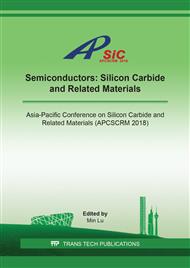p.151
p.157
p.163
p.170
p.176
p.182
p.188
p.194
p.202
Comparison of High Voltage SiC MOSFET and Si IGBT Power Module Thermal Performance
Abstract:
Silicon carbide (SiC) devices have been gradually applied in power electronic for the characteristics of high voltage, high power densities, elevated operating temperature and low switching energy loss. In this paper, a SiC MOSFET welding power module is proposed based on high voltage Si IGBT standard module structure to evaluate the thermal performance. The thermal lateral spread model expounds the expansion of the heat flow in the vertical crossing of a thermal conductor, and thermal resistance distributions of packaging materials in Silicon carbide and Silicon power module are studied through the COMSOL Multiphysics finite element software based on the thermal lateral spread model assumption that minute changes in thermal conductivity would produce no alterations in heat spreading angle. The result indicate that SiC MOSFET module gives the larger thermal resistance than the Si IGBT module with the same encapsulation structure but higher power densities for SiC, what’s more, the solder for die attach and direct bonding copper which include upper copper, substrate and lower copper contribute more thermal resistance in SiC MOSFET module. The differences of thermal Performance in SiC and Si modules can be obtained to benefit us in optimizing SiC MOSFET power module structure design and packaging materials selection.
Info:
Periodical:
Pages:
194-201
Citation:
Online since:
May 2019
Authors:
Price:
Сopyright:
© 2019 Trans Tech Publications Ltd. All Rights Reserved
Share:
Citation:


